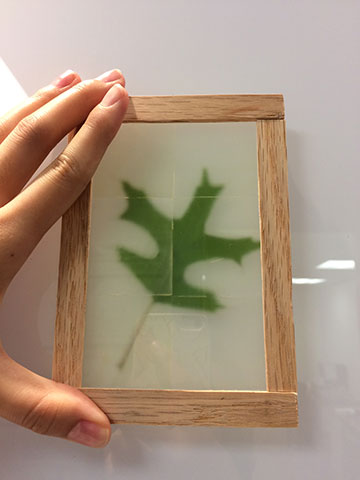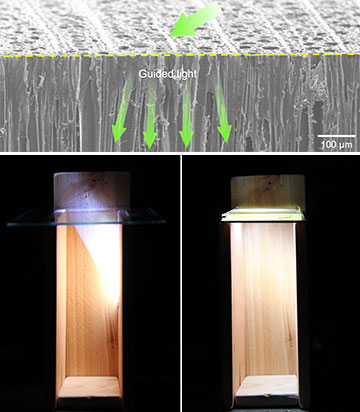
[Image: University of Maryland]
Lighting and indoor climate control sop up more than half of the energy budget of a typical home or commercial building. That has builders on a quest for window materials that can efficiently capture light, yet that also act as strong insulators—in marked contrast to ordinary window glass, which can allow as much as a third of the energy used to heat or cool a building to bleed off.
Now, a team from the University of Maryland, USA, offers one possible (and surprising) solution: Make your windows out of wood (Adv. Energy Mater., doi: 10.1002/aenm.201601122). In a recently published study, the researchers document that a composite material that uses vertically aligned, close-knit wood fibers as visible-light waveguides can achieve transmittance levels of near 90 percent, and can illuminate interiors with low-glare, uniform light. Meanwhile, the material’s thermal conductivity is only a third that of conventional window glass, according to the scientists.
Basswood sheets—minus the lignins
The new study involves experiments with a transparent-wood composite material that the same group unveiled earlier this year (Adv. Mater., doi: 10.1002/adma.201600427). To make the material, the team, led by materials scientist Liangbing Hu, begins by cutting thin sheets of basswood (linden wood) against the grain, so that the wood’s vertically aligned cellulose microchannels—used during the tree’s lifetime to transport water and nutrients up the trunk—are oriented across the sheet’s shortest dimension.
The sheets are then immersed into a solution of boiling sodium hydroxide and sodium sulfate, and subsequently into boiling hydrogen peroxide, to selectively remove the light-absorbing lignin polymers that form structural scaffolding between and within the microchannels. As a last step, the wood, freed of the lignin, is immersed in a liquid-epoxy resin, which takes over the structural heavy lifting that had previously been handled by the now-removed lignin.
The result is a closely packed set of vertically aligned cellulose microchannels that act as cylindrical broadband waveguides—but with “high propagation scattering losses,” according to the study, owing to the microstructural roughness of the fibrous channels. That means that the material transmits light with a high degree of optical haze—a good quality in this instance, as it offers the promise of a more consistent, uniform light, with less glare, than conventional windows.
Happier cats

Once the wood is freed of light-absorbing lignin, the cellulose fibers act as waveguides (top). The resulting transparent-wood composite skylight affords a more consistent, lower-glare interior illumination (bottom right) compared with ordinary glass (bottom left). [Image: University of Maryland]
To test out the material, the group created a small model house with a transparent skylight roof, and ran comparisons between roofs made of the transparent-wood material and roofs of soda-lime glass. The scientists found that the transparent-wood windows showed transmittance of nearly 90 percent through most of the visible wavelength band, very high optical haze levels of 95 percent, and low glare. “The overall transparency for the wood composite,” according to the team, “is comparable to standard glass, plastic, and cellulose-based nanopaper.”
Moreover, because the light is funneled through the same waveguided structure at all times of the day, the illumination is an order of magnitude more uniform and consistent than glass, the study suggests, with the illumination remaining similar as the sun moves across the sky. “This means,” quipped lead author Tian Li, “your cat would not have to get up out of its nice patch of sunlight every few minutes and move over.”
Strong insulator
Perhaps most notable, however, are the material’s thermal properties: The thermal conductivity of the transparent-wood composite, according to the experiments, is comparable to that of the original basswood, and less than a third of the conductivity of glass. The researchers also conducted impact tests on the material, and showed that in contrast to glass, which shattered on impact, the wood stayed intact, sustaining only a dent.
The researchers have patented the process for creating the transparent wood. Given the simplicity and potential scalability of that process, and the properties of the resulting material, they conclude that the composite could be “a promising candidate to improve energy management in buildings.”
